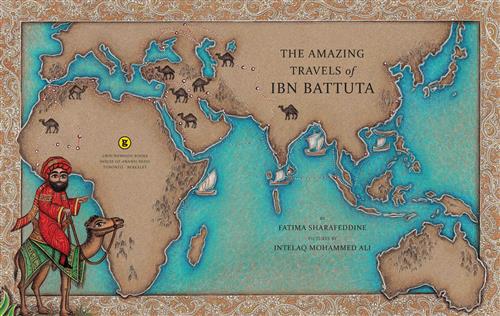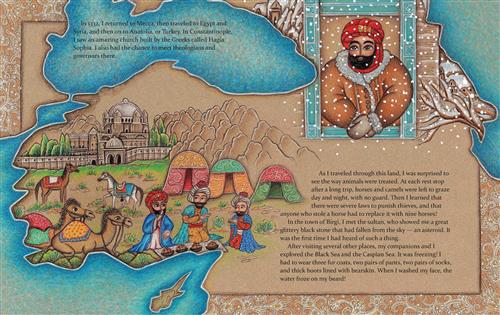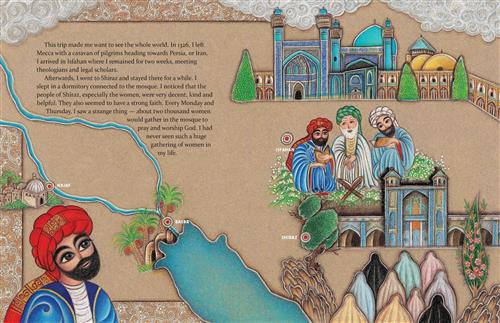The true story of a fourteenth-century traveler, whose journeys through the Islamic world and beyond were extraordinary for his time.
In 1325, when Ibn Battuta was just twenty-one, he bid farewell to his parents in Tangier, Morocco, and embarked on a pilgrimage to Mecca. It was thirty years before he returned home, having seen much of the world. In this book he recalls his amazing journey and the fascinating people, cultures and places he encountered.
After his pilgrimage to Mecca, Ibn Battuta was filled with a desire to see more of the world. He traveled extensively, throughout Islamic lands and beyond — from the Middle East to Africa to Europe to Asia.
Travelers were uncommon in those days, and when Ibn Battuta arrived in a new city he would introduce himself to the governor or religious leaders, and they in turn would provide him with gifts, a place to stay and study, and sometimes they even gave him money to continue his journey. Some of the highlights of his travels included seeing the stunning Dome of the Rock shrine in Jerusalem; witnessing the hundreds of women who gathered to pray at the mosque in Shiraz; visiting the public baths in Baghdad; and meeting the Mogul emperor of India, who made him a judge and eventually sent him to China as an ambassador.
Ibn Battuta kept a diary of his travels, and even though he lost it many times and had to recall and rewrite what he had seen, he kept a remarkable record of his years away. His adventurous spirit, keen mind and meticulous observations, as retold here by Fatima Sharafeddine, give us a remarkable picture of what it was like to be a traveler nearly seven hundred years ago.
The book is beautifully illustrated by Intelaq Mohammed Ali, with maps and travel routes forming the backdrop for many richly painted scenes.
Correlates to the Common Core State Standards in English Language Arts:
CCSS.ELA-LITERACY.RI.4.1
Refer to details and examples in a text when explaining what the text says explicitly and when drawing inferences from the text.
CCSS.ELA-LITERACY.RI.4.3
Explain events, procedures, ideas, or concepts in a historical, scientific, or technical text, including what happened and why, based on specific information in the text.
CCSS.ELA-LITERACY.RI.5.3
Explain the relationships or interactions between two or more individuals, events, ideas, or concepts in a historical, scientific, or technical text based on specific information in the text.
The true story of a fourteenth-century traveler, whose journeys through the Islamic world and beyond were extraordinary for his time.
In 1325, when Ibn Battuta was just twenty-one, he bid farewell to his parents in Tangier, Morocco, and embarked on a pilgrimage to Mecca. It was thirty years before he returned home, having seen much of the world. In this book he recalls his amazing journey and the fascinating people, cultures and places he encountered.
After his pilgrimage to Mecca, Ibn Battuta was filled with a desire to see more of the world. He traveled extensively, throughout Islamic lands and beyond — from the Middle East to Africa to Europe to Asia.
Travelers were uncommon in those days, and when Ibn Battuta arrived in a new city he would introduce himself to the governor or religious leaders, and they in turn would provide him with gifts, a place to stay and study, and sometimes they even gave him money to continue his journey. Some of the highlights of his travels included seeing the stunning Dome of the Rock shrine in Jerusalem; witnessing the hundreds of women who gathered to pray at the mosque in Shiraz; visiting the public baths in Baghdad; and meeting the Mogul emperor of India, who made him a judge and eventually sent him to China as an ambassador.
Ibn Battuta kept a diary of his travels, and even though he lost it many times and had to recall and rewrite what he had seen, he kept a remarkable record of his years away. His adventurous spirit, keen mind and meticulous observations, as retold here by Fatima Sharafeddine, give us a remarkable picture of what it was like to be a traveler nearly seven hundred years ago.
The book is beautifully illustrated by Intelaq Mohammed Ali, with maps and travel routes forming the backdrop for many richly painted scenes.
Correlates to the Common Core State Standards in English Language Arts:
CCSS.ELA-LITERACY.RI.4.1
Refer to details and examples in a text when explaining what the text says explicitly and when drawing inferences from the text.
CCSS.ELA-LITERACY.RI.4.3
Explain events, procedures, ideas, or concepts in a historical, scientific, or technical text, including what happened and why, based on specific information in the text.
CCSS.ELA-LITERACY.RI.5.3
Explain the relationships or interactions between two or more individuals, events, ideas, or concepts in a historical, scientific, or technical text based on specific information in the text.
| Published By | Groundwood Books Ltd — May 1, 2014 |
| Specifications | 32 pages | 9 in x 11.5 in |
| Keywords | history; biography; pilgrimage; discovery and exploration; ancient civilizations; Mecca; religion; world traveller; historical figure; Islam; adaptability; first person narration; summarizing; determining importance; Common Core aligned; CC Literature Key Ideas and Details; grade 4; grade 5; picture book; nonfiction; map; author's note; |
|
Supporting Resources
(select item to download) |
Teacher's Guide |
| Written By | Fatima Sharafeddine is an award-winning Lebanese writer who has twice been nominated for the prestigious Astrid Lindgren Memorial Award. After receiving a B.A. in Early Childhood Education, she moved to the United States to pursue graduate studies. She now divides her time between Beirut and Brussels, where she writes and translates full time. |
| Illustrated by | Intelaq Mohammed Ali is an award-winning Iraqi illustrator, graphic designer and author, who lives in Iran. |
| Written By |
| Fatima Sharafeddine is an award-winning Lebanese writer who has twice been nominated for the prestigious Astrid Lindgren Memorial Award. After receiving a B.A. in Early Childhood Education, she moved to the United States to pursue graduate studies. She now divides her time between Beirut and Brussels, where she writes and translates full time. |
| Illustrated by |
| Intelaq Mohammed Ali is an award-winning Iraqi illustrator, graphic designer and author, who lives in Iran. |
| Audience | ages 7 to 11 / grades 2 to 6 |
| Reading Levels |
Guided Reading Q
Lexile 960L |
| Key Text Features | map; author's note |
| Common Core |
CCSS.ELA-LITERACY.RI.4.3
CCSS.ELA-LITERACY.RI.5.3 CCSS.ELA-LITERACY.RI.4.1 |
“The illustrations, done in a style reminiscent of Persian miniatures, feature large-eyed figures in period dress and evocative glimpses of grand architecture.” — Kirkus Reviews
“Simple and dignified, this is an excellent tool to use when introducing youngsters to Arab history and culture. Highly Recommended.” — Library Media Connection, STARRED REVIEW




